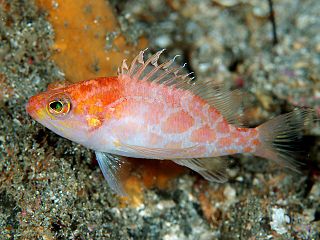
Cardinalfishes are a family, Apogonidae, of ray-finned fishes found in the Atlantic, Indian, and Pacific Oceans; they are chiefly marine, but some species are found in brackish water and a few are found in fresh water. A handful of species are kept in aquariums and are popular as small, peaceful, and colourful fish. The family includes about 370 species.
Grammatidae is a small family of ray-finned fishes which were formerly placed in the order Perciformes but are now regarded as being incertae sedis in the subseries Ovalentaria in the clade Percomorpha. They are commonly known as basslets. They are marine fish found in the tropical western Atlantic Ocean.

Chromis is a genus of fish in the family Pomacentridae. While the term damselfish describes a group of marine fish including more than one genus, Chromis is the largest genus of damselfishes. Certain species within the genus are common in the aquarium trade.

Gymnothorax is a genus of fish in the family Muraenidae found in Atlantic, Indian, and Pacific Oceans. With more than 120 species, it the most speciose genus of moray eels.

Plectranthias is a genus of ray-finned fish in the subfamily Anthiinae, part of the family Serranidae, the groupers and sea basses. They are found in the Atlantic, Indian and Pacific Ocean.

Synodus is a genus of fish in the family Synodontidae found in Atlantic, Indian, and Pacific Oceans.

Pseudanthias is a genus of colourful reef fishes of the subfamily Anthiinae, part of the family Serranidae, the groupers and sea basses. They are found in the Indo-Pacific. The species belonging to this genus have a diet consisting of zooplankton, and are haremic. Fishes currently included in this genus were earlier part of the genus Anthias. Pseudanthias is the largest anthiine genus

Halichoeres are a genus of wrasses found in the Atlantic, Indian and Pacific Oceans.

Elacatinus is a genus of small marine gobies, often known collectively as the neon gobies. Although only one species, E. oceanops, is technically the "neon goby", because of their similar appearance, other members of the genus are generally labeled neon gobies, as well. Except for a single East Pacific species, all reside in warmer parts of the West Atlantic, including the Caribbean and Gulf of Mexico. They are known for engaging in symbiosis with other marine creatures by providing them cleaning service that consists of getting rid of ectoparasites on their bodies. In return, Elacatinus species obtain their primary source of food, ectoparasites.

Starksia is a genus of labrisomid blennies native to the western Atlantic Ocean and the eastern Pacific Ocean. Their typical length is 2 cm (0.79 in) SL. The generic name honours the American ichthyologist Edwin Chapin Starks (1867-1932) of Stanford University for his work on Pacific coastal fishes. As a genus Starksia is distinguished from other labrisomids by their scaled bodies, two obvious soft rays in the pelvic fin and the male's have an intromittent organ which is near to or attached to the first spine of their anal fins, which is also somewhat separated from the fin.

Parapercis is a genus of sandperches belonging to the family Pinguipedidae.

Gramma is a genus of fishes native to tropical waters of the western Atlantic Ocean and the Caribbean Sea.
Coryphopterus is a genus of gobies primarily found in the western Atlantic Ocean, although some species are found in the Indian and/or Pacific oceans.

Varicus is a genus of fish in the family Gobiidae, the gobies. They are native to the western Atlantic Ocean.
Liopropoma carmabi, the candy basslet, is a species of fish in the family Serranidae.

Liopropoma is a genus of marine ray-finned fish, related to the groupers and included in the subfamily Epinephelinae, part of the family Serranidae, which also includes the anthias and sea basses. They are sometimes seen in the marine aquarium trade.

Pseudogramma is a genus of marine ray-finned fish, related to the groupers and classified within the subfamily Epinephelinae of the family Serranidae. They live on coral reefs and exhibit cryptic colors and patterns to conceal them. They are mainly found in the Indo-Pacific with one species in the eastern central Atlantic Ocean.

Lipogramma trilineata, the three-lined basslet, is a species of ray-finned fish from the family Grammatidae. It is found in the western Atlantic Ocean from the waters off southeastern Florida south through the Bahamas into the Gulf of Mexico and the Caribbean Sea as well as the coasts of Central and South America from Quintana Roo, Mexico to Nicaragua, and the seas off Cartagena and those off Venezuela at Curaçao and Bonaire. It occurs underneath rocky and coral ledges as well as occurring in deep reefs and on the outer wall at depths ranging from 22–69 metres (72–226 ft). Its range has been invaded by lionfish, an invasive species in the western Atlantic, which prey on a variety of fish species smaller than 15 centimetres (5.9 in) which means that both adults and juveniles L. trineata are likely prey of lionfish. It has been recorded that in the Bahamas, there has been a near two-thirds decline in the biomass of fish which lionfish prey on over a period of two years. Other species of basslet have been confirmed as prey for lionfishes.
Jeboehlkia is a monotypic genus of marine ray-finned fish, related to the groupers and classified within the subfamily Epinephelinae of the family Serranidae. It is a species of relatively deep water which is found in the western Atlantic Ocean. The only species in the genus is Jeboehlkia gladifer, the bladefin bass.
Charles Richard Robins was an American academic, environmentalist and ichthyologist.















